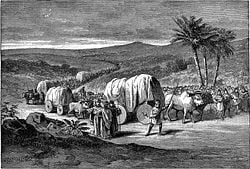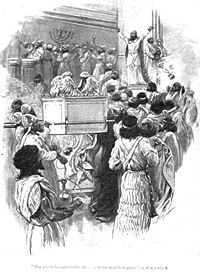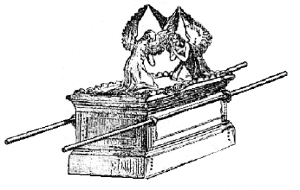Difference between revisions of "Tabernacle (Judaism)" - New World Encyclopedia
m (→History) |
m (→Description) |
||
| Line 7: | Line 7: | ||
==Etymology== | ==Etymology== | ||
| − | The Hebrew word '''''mishkan''''' is related to the word to "dwell," "rest," or "to live in." The Bible often describe God as physically descending in a cloud over the Tabernacle to speak with Moses or otherwise be present among the Israelites. The word ''mishkan'' is also relates to the word presence of ''[[Shekhina]]'', which rested within this divinely ordained mysterious structure and is also present to pious individual Jews wherever they may be. | + | The Hebrew word '''''mishkan''''' is related to the word to "dwell," "rest," or "to live in." The [[Bible]] often describe God as physically descending in a cloud over the Tabernacle to speak with Moses or otherwise be present among the Israelites. The word ''mishkan'' is also relates to the word presence of ''[[Shekhina]]'', which rested within this divinely ordained mysterious structure and is also present to pious individual Jews wherever they may be. |
| − | The commandments for the Tabernacle's construction are taken from the words in the [[Book of Exodus]] when God says to [[Moses]]: "They shall make me a sanctuary, and I will dwell among them. You must make the | + | The commandments for the Tabernacle's construction are taken from the words in the [[Book of Exodus]] when God says to [[Moses]]: "They shall make me a sanctuary, and I will dwell among them. You must make the Tabernacle ('''''mishkan''''') and all its furnishings following the plan that I am showing you." (Exodus 25:8-9) Thus the idea is that God wants this structure built so that it may be a "dwelling," for His presence within the [[Children of Israel]] following the [[Exodus]]. |
| − | ==Description== | + | ==Description and function== |
| − | The Tabernacle was | + | The external perimeter, or ''[[temenos]]'', of the Tabernacle was comprised of a rectangular perimeter fence of fabric, poles, and staked cords. This rectangle was carried by the [[Levite]]s and erected whenever the Israelites camped oriented to the east. In the center of its enclosure was a rectangular sanctuary draped with goats'-hair curtains, and the roof was made from rams' skins. |
[[Image:Aaron-ark.jpg|thumb|250px|Aaron in the Holy of Holies]] | [[Image:Aaron-ark.jpg|thumb|250px|Aaron in the Holy of Holies]] | ||
| − | Inside, the inner sanctuary was divided into two areas, the Holy Place and the Most Holy Place. These two compartments were separated by a curtain or veil. Entering the first space, one would see three pieces of sacred furniture: a seven-branched oil lampstand on the left (south), a table for 12 loaves of show bread on the right (north), and straight ahead before the dividing curtain (west) was an altar for incense-burning. Beyond this curtain was the cube-shaped inner room | + | Inside, the inner sanctuary was divided into two areas, the [[Holy Place]] and the [[Most Holy Place]], or "Holy of Holies." These two compartments were separated by a curtain or veil. Entering the first space, one would see three pieces of sacred furniture: a seven-branched oil lampstand on the left (south), a table for 12 loaves of show bread on the right (north), and straight ahead before the dividing curtain (west) was an altar for incense-burning. Beyond this curtain was the cube-shaped inner room, the ''Holy of Holies'' (''kodesh hakodashim''). This sacred space originally contained a single article, the [[Ark of the covenant]]. However, other items were added later, including a vessel containing [[manna]] and Aaron's rod, which had miraculously budded as a sign of his divine priesthood. |
==Contents== | ==Contents== | ||
Revision as of 17:54, 7 September 2007
The Tabernacle was a portable central place of worship for the Israelites from the time they left ancient Egypt following the Exodus, until the time its core elements were made part of the final Temple in Jerusalem about the 10th century B.C.E.. It is known in Hebrew as the Mishkan ( משכן "Place of [Divine] dwelling").
The English word "tabernacle" is derived from the Latin word tabernaculum meaning "tent, hut, booth." The word Sanctuary is also used as its name, as well as the phrase "the tent of meeting."
Etymology
The Hebrew word mishkan is related to the word to "dwell," "rest," or "to live in." The Bible often describe God as physically descending in a cloud over the Tabernacle to speak with Moses or otherwise be present among the Israelites. The word mishkan is also relates to the word presence of Shekhina, which rested within this divinely ordained mysterious structure and is also present to pious individual Jews wherever they may be.
The commandments for the Tabernacle's construction are taken from the words in the Book of Exodus when God says to Moses: "They shall make me a sanctuary, and I will dwell among them. You must make the Tabernacle (mishkan) and all its furnishings following the plan that I am showing you." (Exodus 25:8-9) Thus the idea is that God wants this structure built so that it may be a "dwelling," for His presence within the Children of Israel following the Exodus.
Description and function
The external perimeter, or temenos, of the Tabernacle was comprised of a rectangular perimeter fence of fabric, poles, and staked cords. This rectangle was carried by the Levites and erected whenever the Israelites camped oriented to the east. In the center of its enclosure was a rectangular sanctuary draped with goats'-hair curtains, and the roof was made from rams' skins.
Inside, the inner sanctuary was divided into two areas, the Holy Place and the Most Holy Place, or "Holy of Holies." These two compartments were separated by a curtain or veil. Entering the first space, one would see three pieces of sacred furniture: a seven-branched oil lampstand on the left (south), a table for 12 loaves of show bread on the right (north), and straight ahead before the dividing curtain (west) was an altar for incense-burning. Beyond this curtain was the cube-shaped inner room, the Holy of Holies (kodesh hakodashim). This sacred space originally contained a single article, the Ark of the covenant. However, other items were added later, including a vessel containing manna and Aaron's rod, which had miraculously budded as a sign of his divine priesthood.
Contents
The detailed outlines for the Tabernacle and its leaders are enumerated in the Book of Exodus:
- Chapter 25 [1] : Materials needed, the Ark, the table for 12 showbread, the Menorah.
- Chapter 26 [2] : The Tabernacle, the beams, partitions.
- Chapter 27 [3] : The copper altar, the enclosure, oil.
- Chapter 28 [4] : Vestments for the priests, the ephod garment, ring settings, the breastplate, robe, head-plate, tunic, turban, sashes, pants.
- Chapter 29 [5] : Consecration of priests and altar.
- Chapter 30 [6] : Incense altar, washstand, anointing oil, incense.
History
God gave detailed instructions to Moses concerning the construction and contents of the Tabernacle while Moses was on Mount Sinai, at which time Moses builds a "tent of meeting" in which he speaks "face to face" with God. (After the Tabernacle was built, it too would be called the "tent of meeting.")
Moses intercedes for the people, and God renews the Ten Commandments after Moses spends and additional 40 days fasting on the mountain. Moses collects the congregation, impresses upon them the crucial importance of keeping the sabbath, and requests gifts for the Tabernacle sanctuary. The people respond willingly. Aaron (now in priestly garments) consults with Moses, while construction of the tabernacle nears completion.
The master craftsmen Bezaleel and Aholiab complete the instructions for making the Tabernacle and its contents, including the sacred Ark of the Covenant. Far from being a mere tent which housed the Ark, the Tabernacle is described as a richly ornate structure with secure but portable foundations of pure silver, collected from the required half-shekel offerings of 603,000 Israelite men.
Aaron and his sons are solemnly consecrated as priests and clothed in their sacred garments. Then, "the glory of the Lord" fills the Tabernacle. During the Israelites's travels, whenever the cloud of God's presence lifted from above the Tabernacle, they would set out,
"but if the cloud did not lift, they did not set out —- until the day it lifted. So the cloud of the Lord was over the tabernacle by day, and fire was in the cloud by night, in the sight of all the house of Israel during all their travels."
After the Israelites entered Canaan, the Tabernacle was established semi-permanently at Shiloh (Joshua 18:1). It was at the entrance to the Tent of Meeting that the Israelites cast lots to determine the distribution of land among the tribes (Joshua 19:51). Soon a dispute about centrality of the Tabernacle arose between the Israelites who had settled in Canaan proper and those—the tribes of Gilead, Reuben, Gad, part of the tribe of Manasseh—who had settled east of the Jordan River. Aaron's grandson Phinehas and elders of the western tribes confronted the eastern settlers, demanding: "How could you turn away from the Lord and build yourselves an altar in rebellion against him now?" (Josh 22:17) A compromise was reached in which the eastern tribes agreed not to use the altar for sacrifices, and the western delegrates allowed the altar to stand as a "a witness between us and you and the generations that follow, that we will worship the Lord."
Shiloh became a place of pilgrimage for Israelites who wished to offer their tithes and sacrifices, but local altars were also allowed at such sacred sites such as the high places of Gilgal, Bethel, Ramtha, Mizpah, and—according to Samaritan tradition—Gerizim. The Tabernacle's entrance would became a place of infamy in the days of the judge Eli, when his sons used their positions to commit fornication with women who served there. (1 Samuel 2:22)
When King David conquered Jerusalem, he transfered the Ark of the Covenent to a high place shrine in his new capital, while Shiloh continued as a center of priestly and prophetic activity. When Solomon built the Temple of Jerusalem, the main elements of the Tabernacle were incorporated into the newly built permanent temple.
Relationship to the Golden Calf
Some rabbis have commented on the proximity of the narrative of the Tabernacle with that of the episode known as the sin of the Golden Calf which begins in the Book of Exodus 32:1-6 [7]. Maimonides asserts that the Tabernacle and its accoutrements, such as the golden Ark of the Covenant and the golden Menorah were meant as "alternates" to the human weakness and needs for physical idols as seen in the Golden Calf episode. Others scholars, such as Nachmanides disagree and maintain that the Tabernacle's meaning is not tied in with the Golden Calf but instead symbolizes higher mystical lessons that symbolize God's constant closeness to the Children of Israel.
Blueprint for synagogues
Synagogue construction over the last two thousand years has followed the outlines of the original Tabernacle, which was of course also the outline for the temples in Jerusalem until they were destroyed. Every synagogue has at its front an ark, aaron kodesh, containing the Torah scrolls comparable to the Ark of the Covenant which contained the tablets with Ten Commandments. This is the holiest spot in a synagogue equivalent to the Holy of Holies.
There is also usually a constantly lighted lamp, ner tamid, or a candelabrum lighted during services, near this spot similar to the original Menorah. At the center of the synagogue is a large elevated area, known as the bimah where the Torah is read. This is equivalent to the Tabernacle's altars upon which incense and animal sacrifices were offered. On the main holidays the priests, kohanim, gather at the front of the synagogue to bless the congregation as did their priestly ancestors in the Tabernacle from Aaron onwards.
Prayer in the Tabernacle
Twice a day a priest would stand in front of the golden prayer altar and burn fragrant incense. Other procedures were also carried out in the Tabernacle.
Other uses
Within Catholicism, a tabernacle is a cupboard or boxlike receptical for the exclusive reservation of the blessed Sacrament - the bread and wine used during the rite of Holy Communion. In the Early Christian times such tabernacles containing the sacred species were kept within private houses where Christians met for church, for fear of possible persecution.
The Tabernacle is also seen in some Christian circles as representing Jesus Christ.
External links
- [An exact, full-scale replica of the Tabernacle is under construction!
- An excellent study of the Tabernacle in everyday English
- The offerings of the Tabernacle
- The Tabernacle and its contents, in Hebrew, with many diagrams
- Jewish Encyclopedia article
- Tabernacle model Christian Perspective
- Tabernacle Model and Free Tabernacle Lessons
- Tabernacle from a Christian Perspective - Thomas Newberry editor of the Newberry Reference Bible
- The Tabernacle model at Glencaírn museum
- "Tabernacle Shadows"
Credits
New World Encyclopedia writers and editors rewrote and completed the Wikipedia article in accordance with New World Encyclopedia standards. This article abides by terms of the Creative Commons CC-by-sa 3.0 License (CC-by-sa), which may be used and disseminated with proper attribution. Credit is due under the terms of this license that can reference both the New World Encyclopedia contributors and the selfless volunteer contributors of the Wikimedia Foundation. To cite this article click here for a list of acceptable citing formats.The history of earlier contributions by wikipedians is accessible to researchers here:
The history of this article since it was imported to New World Encyclopedia:
Note: Some restrictions may apply to use of individual images which are separately licensed.



